
Bio-ship Paladin, known in Japan as Space Battleship Gomora, is a 1990 horizontally scrolling shoot 'em up arcade game released by UPL and distributed by Sammy Corporation for North American manufacture. It was later ported to the Sega Mega Drive. While the game is essentially a standard horizontally scrolling shoot 'em up, it has an innovation that makes it unique in the genre. The player flies a spaceship which has the standard forward guns to be found in all horizontal scrollers, but it also possesses a weapon that can be manually targeted with a crosshair, in the same manner as in the game Missile Command. This allows the player to fire in any direction with pinpoint accuracy, and adds an extra level of strategy to the game. The game saw an almost arcade perfect port on the Mega Drive, albeit with a few changes that actually enhanced the look of the game such as added parallax scrolling backgrounds in the second level. It would eventually see a worldwide re-release as part of the Arcade Archives series for Nintendo Switch and PlayStation 4 on August 5, 2021.
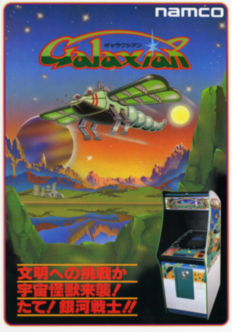
Galaxian is a 1979 fixed shooter arcade video game developed and published by Namco. The player assumes control of the Galaxip starfighter in its mission to protect Earth from waves of aliens. Gameplay involves destroying each formation of aliens, who dive down towards the player in an attempt to hit them.
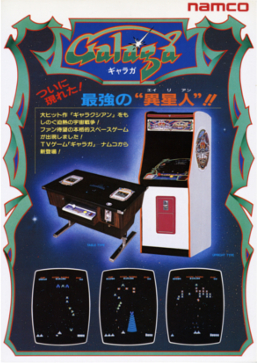
Galaga is a 1981 fixed shooter arcade video game developed and published by Namco. In North America, it was released by Midway Manufacturing. It is the sequel to Galaxian (1979), Namco's first major video game hit in arcades. Controlling a starship, the player is tasked with destroying the Galaga forces in each stage while avoiding enemies and projectiles. Some enemies can capture a player's ship via a tractor beam, which can be rescued to transform the player into a "dual fighter" with additional firepower.

Astron Belt (アストロンベルト) is a LaserDisc video game in the form of a third-person, space combat rail shooter, released in arcades in 1983 by Sega in Japan, and licensed to Bally Midway for release in North America. Developed in 1982, it was the first major arcade laserdisc video game. The game combines full-motion video (FMV) footage from the laserdisc with real-time 2D graphics. The arcade game was available in both upright and cockpit arcade cabinets, with the latter having illuminated buttons on the control panel, a larger 25" monitor, and a force feedback vibrating seat.

Galaga '88 is a 1987 fixed shooter arcade video game by Namco. It is the third sequel to Galaxian. It features significantly improved graphics over the previous games in the series, including detailed backgrounds, larger enemies and greater ship details. The game runs on Namco System 1 hardware.
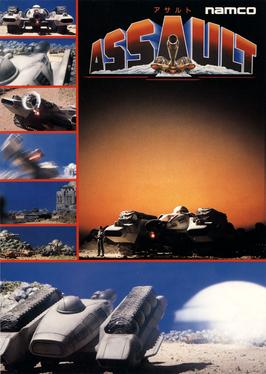
Assault is a 1988 multi-directional shooter arcade game developed and published by Namco. It was licensed to Atari Games for release in North America. Controlling a caterpillar-tread self-propelled gun, the player is tasked with completing each of the game's eleven stages while shooting enemies and avoiding projectiles. It uses a twin-stick control layout, similar to games such as Battlezone. The plot involves the human race searching for new planets after Earth reaches its maximum population - after discovering an exo-planet 35,000 light years away from the Milky Way, they enslave the planet's natives and take control, leading to the planet's native population vowing to abolish the humans and bring peace to their world. The protagonist who rides the aforementioned self-propelled gun which players control, is one such native.
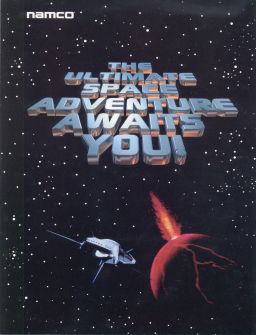
Galaxian3: Project Dragoon is a 3D rail shooter video game developed and published by Namco. It was originally a theme park attraction designed for the International Garden and Greenery Exposition in Japan, and was later released as an arcade game in 1992. The game involves players controlling a starship named the Dragoon in its mission to destroy Cannon Seed, a superweapon set to destroy what is left of the human race.

RayForce is a vertically scrolling shooter by Taito for the Taito F3 arcade hardware and released in 1994. It was ported to the Sega Saturn in 1995, Microsoft Windows in 1997, then rereleased for iOS in 2012 and Android in 2017.

Grobda is a 1984 multidirectional shooter arcade video game developed and published by Namco. It is a spin-off from Xevious, as the player's tank first appeared in that game as an enemy. It runs on Namco Super Pac-Man hardware but with a video system like that used in Mappy and The Tower of Druaga, and it also uses a DAC for the "Get Ready" speech sample at the start of each round.

Tank Force is a 1991 multi-directional shooter arcade game developed and published in Japan by Namco. It was designed by Yutaka Kounoe, whose works include Dig Dug, Lucky & Wild, and Point Blank. The game is a successor installment to Namco's Battle City (1985), itself a successor to Tank Battalion (1980). In 2017, the two-player version was re-released for the Nintendo Switch as part of the Namco Museum compilation.

Sky Fox is a 1987 arcade video game developed by Jaleco and licensed to Nichibutsu. It was originally released in Japan and Europe as Exerizer (エクセライザー) as an indirect follow-up to Jaleco's 1983's Exerion and 1984's Exerion II: Zorni. It is a fixed shooter, setting the player in the role of a space pilot fighting against female alien invaders and space monsters under their control. The game was mostly well-received by Western game critics, albeit some criticized it for its depiction of women.

Metal Hawk is a 1988 multidirectional shooter arcade game developed and published by Namco. Assuming control of the titular attack helicopter, the player is tasked with using a machine gun and air-to-surface missiles to destroy enemies and earn a certain number of points before the timer runs out, all while avoiding collision with ether enemy projectiles and obstacles. The Metal Hawk can change its altitude to allow it to either rise higher in the air or lower towards the ground. It ran on the Namco System 2 arcade board.
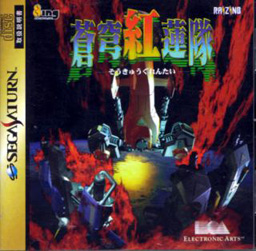
Soukyugurentai, also known as Terra Diver, is a vertical-scrolling shooting game by Raizing originally released as an arcade game for the ST-V platform in 1996. The game was ported to the Sega Saturn and PlayStation in 1997, with neither port being released outside of Japan.

Starblade is a 1991 3D rail shooter arcade game developed and published by Namco. Controlling the starfighter FX-01 "GeoSword" from a first-person perspective, the player is tasked with eliminating the Unknown Intelligent Mechanized Species (UIMS) before they wipe out Earth. Gameplay involves controlling a crosshair with a flight yoke stick and destroying enemies and their projectiles before they inflict damage on the player.

NebulasRay is a vertical-scrolling shooter arcade game developed and released by Namco in 1994. Players take control of a starship named the Fighting Ray through a series of levels in its mission to eradicate the universe of an intergalactic organization named the Master Force. It is noteworthy for its usage of pre-rendering, where 3D models are converted into 2D sprites, creating the illusion of a 3D world.
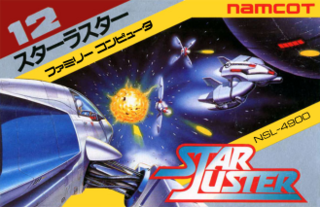
Star Luster is a 1985 space combat simulator video game developed and published by Namco for the Family Computer in Japan. and adapted for play in arcades via the Nintendo VS. System. Star Luster is set in the same universe as Namco's Bosconian (1981), and the gameplay has strong similarities to Atari, Inc.'s Star Raiders from 1979.
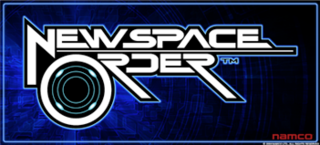
New Space Order is an unreleased real-time strategy arcade game under development by Namco Bandai Games for Japan. Controlling a fleet of battleships, players would explore the void of space to gather resources and fight off enemy fleets and destroy entire planets. Players could construct network systems to distribute resources to other players and construct new ship types to deploy into battle. The plot involves an intergalactic organization, the United Galaxy Space Force, discovering an unknown extraterrestrial species that plans to wipe out all of mankind. It was made for the Namco System N2 arcade board.

Star Trigon is a 2002 puzzle arcade game published in Japan by Namco. Ports for iPod, iOS devices and Windows were also released. In the game, the player controls one of three characters — Wataru Hoshi, Chuta Bigbang and Susumu Hori — the objective being to rescue creatures known as "Uchijins" by hopping from planet to planet to draw triangles and capture them. The player will automatically circle the planet they are on, requiring timed jumps to avoid falling off the playfield. It ran on the Namco System 10 hardware.

Mobile Suit Gundam Extreme VS-Force is a portable spin-off of the Extreme Vs. series, developed by Bandai Namco Studios and Lancarse for PlayStation Vita.

Starblade: Operation Blue Planet is an unreleased 3D rail shooter arcade game in development by Namco. A sequel to the game Starblade (1991), the player controls the GeoCalibur starship in its mission to wipe out an alien race known as the Unknown Intelligent Mechanized Species. Gameplay involved using a flight-yoke controller to control a crosshair and shoot down enemies, while avoiding incoming obstacles and projectiles. The player has a shield that depletes when inflicted with enemy fire. Only one level was completed. It ran on the PlayStation 2-based Namco System 246 arcade hardware.



















